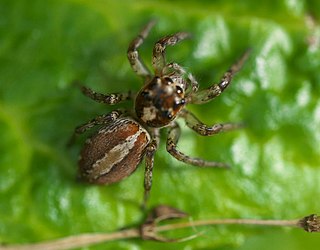
Attulus is a genus of jumping spiders that was first described by Eugène Louis Simon in 1889. The name is a diminutive form of a common prefix for salticid genera, -attus.
Bianor is a genus of boreal jumping spiders that can grow to 3 and 4 mm. The robust shiny body and northerly distribution are distinctive. Males can be easily recognized by his swollen forelegs and females have orange legs. It was first described by George and Elizabeth Peckham in 1886, who names it after the mythical son of Hercules.

Chalcoscirtus is a genus of jumping spiders that was first described by Philipp Bertkau in 1880. The name is derived from the Ancient Greek chalc-, meaning "copper", and scirt-, meaning "leap".

Chinattus is a genus of jumping spiders that was first described by D. V. Logunov in 1999. The name is a combination of "China" and -attus, a common suffix for salticid genera.

Evarcha is a genus of spiders in the family Salticidae with 85 species distributed across the world.

Habrocestum is a genus of jumping spiders first described in 1876. They mostly occur in Eurasia and Africa, though one species has been found in Australia and another on the Solomon Islands.
Helicius is a genus of the spider family Salticidae.
Heliophanoides is a genus of the spider family Salticidae.
Langona is a spider genus of the family Salticidae (jumping spiders).

Pancorius is a genus of Asian jumping spiders that was first described by Eugène Louis Simon in 1902. They are similar to Hyllus.

Plexippoides is a genus of jumping spiders that was first described by Jerzy Prószyński in 1984. The name means "having the likeness of Plexippus"

Pseudicius is a genus of the jumping spiders first described by Eugène Simon in 1885. The name is combined of Greek pseudo "false" and the salticid genus name Icius. The small genus Wesolowskana should possibly be included in this genus. There is some dispute whether Afraflacilla is a distinct genus or should be included in Pseudicius. Festucula and Marchena are other close relatives, these genera form a monophyletic group.

Stenaelurillus is a genus of jumping spiders that was first described by Eugène Louis Simon in 1886. Most species live in Africa, with some species found in Asia, including China. All species have two white longitudinal stripes on the carapace, and both sexes show strong bristles around the eyes. The name is a combination of the Greek sten- "narrow" and the salticid genus Aelurillus.

Synagelides is a genus of Asian jumping spiders that was first described by W. Bösenberg & Embrik Strand in 1906. This genus and Agorius are separated as a genus group, sometimes called subfamily Agoriinae, but more recently downranked to tribe Agoriini of the Salticoida clade in subfamily Salticinae.
Yllenus is a genus of jumping spiders that was first described by Eugène Louis Simon in 1868. Until 2019, it was considered a senior synonym of Pseudomogrus, and many of the species formerly placed here were transferred to new genera Logunyllus and Marusyllus by Jerzy Prószyński in 2016.
Marusyllus is a genus of spiders in the family Salticidae, found in Russia, Central Asia, the Indian subcontinent and China.
Nandicius is a genus of spiders in the family Salticidae. It was first described in 2016 by Jerzy Prószyński. As of 2017, it contains 7 Asian species.
Phintella parva is a jumping spider species that lives in China, Japan and Korea. The species was originally named Icius parvus by Wanda Wesołowska in 1981, but was transferred to the genus Phintella in 1983 by Jerzy Prószyński and renamed Phintella parva when both sexes were described in 1992.

Habronattus mexicanus is a jumping spider species in the genus Habronattus. It is the type species of that genus.










